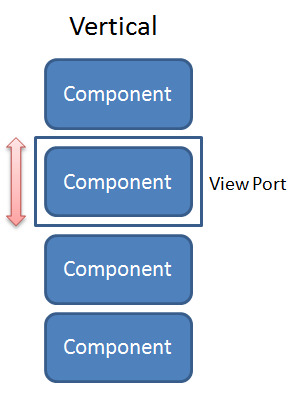Cardlayout
- Demonstration: N/A
- Java API: org.zkoss.zkmax.zul.Cardlayout
-
JavaScript API: zkmax.layout.Cardlayout
Employment/Purpose
Cardlayout is a layout that allows end-users to change component like
changing cards. The selectedIndex will decide which component will be
shown in the view port. When the value of selectedIndex changes or
when next() or previous() is called, transition of components
through animation will occur whereas the orient attribute decides
whether the direction of the animation is horizontal or vertical.


Example

<cardlayout id="card" width="300px" height="200px" style="border:3px solid orange" selectedIndex="1">
<div vflex="1" hflex="1" style="background-color:yellow;padding:20px">card 1</div>
<div vflex="1" hflex="1" style="background-color:green;padding:20px">card 2</div>
<div vflex="1" hflex="1" style="background-color:skyblue;padding:20px">card 3</div>
</cardlayout>
<hlayout>
<button onClick="card.previous()">previous</button>
<button onClick="card.next()">next</button>
<button
onClick='card.setOrient("horizontal".equals(card.getOrient()) ? "vertical" : "horizontal")'>
change orient
</button>
</hlayout>
Size Issue
If Cardlayout of hflex is set as "min", it’s width will be decided
by the selected component’s size when initializing. On the other hand,
if the child component of Cardlayout sets hflex="1", its width will
equal to Cardlayout’s width.
Swipe Distance Issue
On tablet, think for user experience Cardlayout will change component
if swipe distance bigger than one-third of it’s width/height. If
Cardlayout’s width/height is smaller than 90px, the minimum trigger
distance will be 30px. Another case is Image. If Cardlayout’s child
component is Image, it will use default swipe distance trigger
setting.
Supported Events
- Inherited Supported Events: XulElement
Supported Children
*ALL
Version History
| Version | Date | Content |
|---|---|---|
| 6.5.0 | August, 2012 | org.zkoss.zkmax.zul.Cardlayout was introduced. |